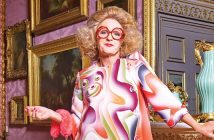If you’re after an art fix with period drama aplenty, the Tate Britain’s Sargent and Fashion exhibition charts John Singer Sargent’s cataclysmic rise to fame as the most notable portrait painter of his age, with almost 60 enduringly iconic and unashamedly lavish depictions of the great and the good, dressed to impress. Organised thematically rather than chronologically, the exhibition opens with Sargent’s striking portrait of Aline de Rothschild, Lady Sassoon (1907) so even if you’re unfamiliar with his work, it will take you five seconds to work out what it was that each of the subjects had in common and it wasn’t necessarily beauty.
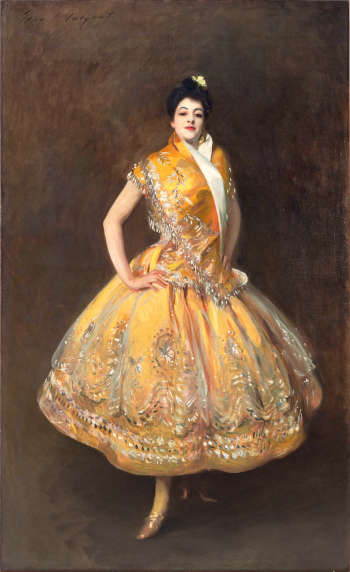
John Singer Sargent, La Carmencita, 1890. Paris, musée d’Orsay. Photo © Musée d’Orsay, Dist. RMN-Grand Palais Patrice Schmidt
An American born in Florence, Italy in 1856 Sargent was trained in Paris and spent the majority of his life in Europe, working from his studio in Tite Street, Chelsea and forming friendships with the likes of his neighbour and fellow artist James Abbott McNeill Whistler, while works such as Carnation, Lily, Lily, Rose (1885-6) painted in the scenic Cotswold town of Broadway at the home of a friend, shows the artist’s immersion into British society and just how feted he was by everyone from the aristocracy and royalty to pillars of the art world.
Despite the exhibition’s curators having been criticised for dumbing down Sargent’s legacy by including a selection of sumptuous dresses and accessories in the hope of attracting a wider, social media savvy audience, the items on display (which one journalist described as a ‘frock horror’) illustrate his skill at replicating a host of luxurious fabrics on the canvas whilst conveying the wealth and privilege of his sitters at a time when to be painted by Sargent was seen as the pinnacle of social success. In reinforcing the reputation of his sitters he augmented his own and became one of the most successful painters of a generation.
Sargent took great pains to pose his sitters in as revealing a way as he portrayed their attitude or expression, spending almost as much time planning the work including the sitter’s outfit as he did on painting them in order to more fully convey an insight into their personality, status or occupation as in the case of leading Victorian actress Ellen Terry who posed in the green beetle-wing-embellished costume she wore as Lady Macbeth (1889) and the New York music hall dancer La Carmencita whom Sargent was so captivated by that he begged her to sit for him, a compliment indeed considering that most of society were queuing around the block to commission him.
No work of Sargent’s ever created more of a sensation than Madame X (1884) however; the anaemic-looking, pointy-nosed Madame Pierre Gautreau who went from being the unknown American wife of a French banker to one of the most notorious women of the day. Dressed in a simple floor length sleeveless black dress with an unashamedly seductive heart-shaped bodice and gold straps to show off her luminously pale skin, she was so horrified at being hailed a femme fatale when it was first exhibited at the Paris Salon that she begged Sargent to rework the painting and return the alluring fallen dress strap to its proper place on her shoulder. This exhibition gives this captivating work, on loan from the Metropolitan Museum in New York, almost a room to itself, accompanied by the copy Sargent abandoned the same year. Alas, the dress which caused so much furore isn’t present, but the work is enough to illustrate the magnetism of the ‘Little Black Dress’ long before Coco Chanel claimed it as her own.
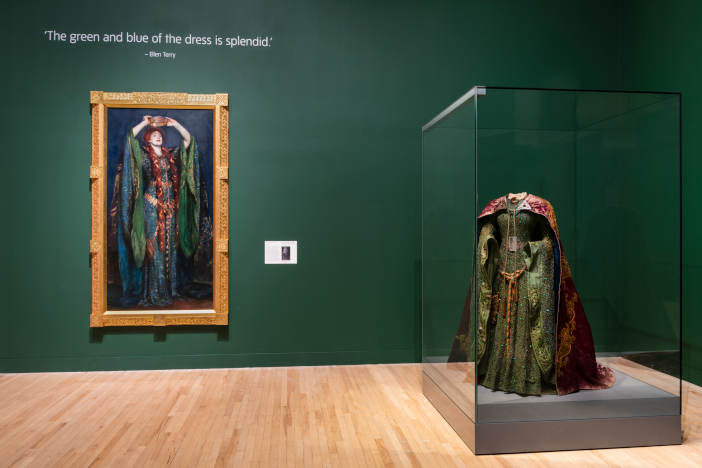
Sargent and Fashion installation view with Ellen Terry as Lady Macbeth and Beetle-Wing Dress. Photo © Tate (Jai Monaghan)
Having previously believed the Parisian art scene to be liberally-minded, Sargent was so exasperated by the reaction to Madame X that he relocated to Britain where he was welcomed with open arms. Far from being an impoverished artist living in a garret, dreaming of fame and fortune, Sargent was an astute business man who offered his clients immortality by the metre. Being painted by Sargent was the ultimate calling card and the commercialism of his portraiture is one that offers a comprehensive insight into the movers and shakers of the day in a way that an artist who had painted only for his own gratification would never have afforded us.
In light of Sargent’s own marketing prowess I very much doubt that he would be in the least offended at the curatorial decision to appeal to the younger generation by pushing the fashion angle of his artistic legacy, nor should Sargent devotees be anything but delighted at being given the chance to compare the selection of garments alongside some of his most lauded masterpieces, showcasing as they do his keen gift of perception, technical brilliance and eye for detail.
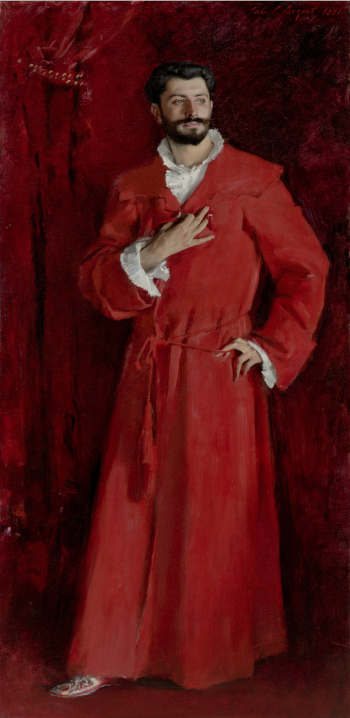
John Singer Sargent, Dr. Pozzi at Home, 1881. The Armand Hammer Collection
Richard Ormond, former director of the National Maritime Museum in London and deputy director of the National Portrait Gallery, is not only the grand-nephew of the painter but an authority on Sargent’s work andd once explained in an interview with The Smithsonian Magazine, “Sitting for Sargent even for a few hours might have been rather intimidating for the subjects…Someone would turn up in a new dress especially chosen for the occasion and he’d say, ‘I don’t want that’. He stage-managed it, and he expected other people to play their part. The subjects, no matter how famous they were, were there to create a good figure to express themselves, so he could capture them.”
There is nothing tenuous in the connection between Sargent and fashion, on the contrary, no-one understood how powerful a tool costume could be more than he did. At no point do the ‘props’ of the Tate’s Sargent and Fashion exhibition distract from the works themselves, rather they draw you further in and conjure up the atmosphere of the artist’s own studio. If you have imagination enough, you can almost pretend the exhibition is an elegant soiree in which the illustrious sitters of Sargent’s very own Belle Epoque mingle with champagne glasses in hand admiring their flattering gilt-framed reflections as vainly as Dorian Gray. Alas, the only person conspicuously absent is the allusive Sargent.
Velvet or silk, dresses with bustles to the more streamlined hourglass of the late nineteenth century, Sargent displays his painterly skill with every garment. Even the male sitters are not without flamboyance, most notably Oscar Wilde’s friend W. Graham Robertson who wears a long black coat, carries a jade-handled cane, and has a poodle with a pink ribbon sitting at his feet, while the renowned French gynaecologist Samuel Jean de Pozzi is portrayed in an almost Devilish-looking floor length red robe in Doctor Pozzi at Home (1881) which inspired the 2019 Julian Barnes biography ‘The Man in the Red Coat’.
Although he once proclaimed, “I do not judge, I only chronicle,” Sargent’s talent for capturing the dazzling superficiality of the polite society which provided his daily bread with a wryness which seems to allow us in on the joke over a hundred years on, has made his portfolio one to be enjoyed in much the same way as a Henry James or Edith Wharton novel about the cut-throat snobbery of Victorian and Edwardian society – on whatever level you prefer.
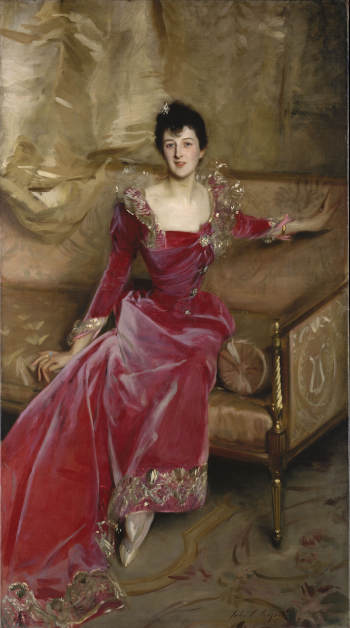
Mrs. Hugh Hammersley, 1892 – Sargent, John Singer (1856-1925)
Artwork Location: Metropolitan Museum of Art, New York, USA.
Fellow American James was an untiring champion of Sargent following their first meeting in Paris in 1884 and even encouraged Sargent to relocate from Paris to London. It’s appropriate then that so many Sargent portraits have been chosen as Penguin book covers for Henry James novels over the years. Friends of James, including Edith Wharton, commissioned Sargent to paint the writer in celebration of his 70th birthday, although it was not met with universal approval. When the painting went on view at London’s Royal Academy in May 1914, a suffragette named Mary Wood attacked it with a meat cleaver, slashing the canvas three times before being apprehended. In a letter to a friend James wrote bemusedly, “Yes, it was a nasty one, or rather a nasty three, for she got at me thrice over before the tomahawk was stayed. I naturally feel very scalped and disfigured, but you will be glad to know that I seem to be pronounced curable.”
Capitalising on the demand for his oil portraits into the turn of the 20th century, Sargent wrote to a friend in 1907, “I abhor and abjure them and hope never to do another, especially of the Upper Classes.” The First World War seems to have been the catalyst that allowed Sargent to turn his back on the genre for which he was best known. “I hate to paint portraits!…Portraiture may be alright for a man in his youth, but after forty I believe that manual dexterity deserts one, and, besides, the colour-sense is less acute. Youth can better stand the exactions of a personal kind that are inseparable with portraiture. I have had enough of it.”
Sargent completed over 2,000 watercolours, 900 oil paintings and countless sketches and preliminary studies during his career but all but gave up oil portraits by 1910 and instead satisfied eager friends and acquaintances with more spontaneous charcoal portraits completed within a couple of hours. There are around 750 of these in existence including a handsome 1923 profile of the Queen Mother when she was Lady Elizabeth Bowes-Lyon, completed during the year of her marriage to the Duke of York, later George VI. Sargent spent his final years favouring watercolour landscapes, often worked whilst travelling.
To my mind, Sargent possessed a genius for every genre and medium he turned his hand to, from his realist series of World War I including the epic and horrifying Gassed (1919) to society oil portraits and charcoal sketches or watercolour landscapes. The Sargent and Fashion exhibition proved an unmissable opportunity to enjoy some of my favourite works like the captivating Lady Agnew of Lochnaw (1892), the tender Mrs Fiske Warren & Her daughter Rachel (1903) and the seductive Mrs Hugh Hammersley (1892) who, as the wife of a wealthy banker and fashionable London hostess epitomises the glamour and hedonism of the social milieu who needed Sargent as much as he they, whether he liked it or not.
Sargent and Fashion at Tate Britain, Millbank, London SW1P 4RG until 7 July 2024. Open daily 10:00 – 17:00. Tickets £22, concessions available. For more information and tickets please visit the website.
Featured image: Sargent and Fashion installation view with Lady Agnew of Lochnaw, 1892 © Tate (Jai Monaghan).


